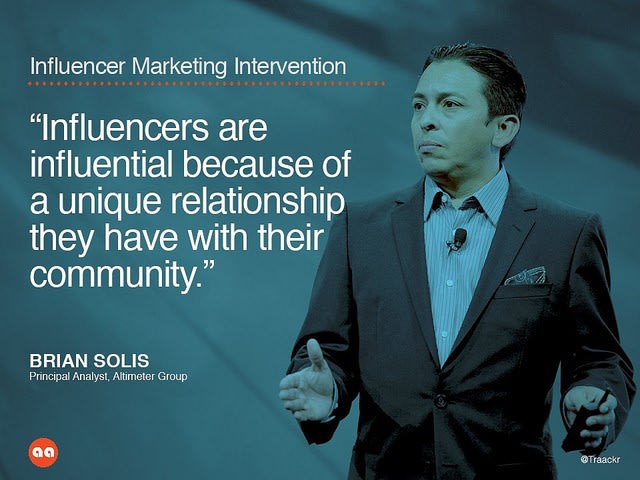How influencer marketing is changing the way brands advertise
Written by Samantha Sherer on 6 minute read
Throughout the digital marketing landscape, the popularity of influencer marketing is on the rise.

Everyone is talking about it, and the effect it has on the industry is palpable. In 2018, influencer marketing is set to continue to be a force to be reckoned with.
This trend has resulted in significant changes to advertising strategies. To understand why, let’s first look at what influencer marketing is.
Defining influencer marketing
Influence does not necessarily equal popularity. Popularity suggests large followings, subjecting content to a big audience. An influencer is someone who can affect consumers' thinking or behavior. They have developed a rapport with their audience, and the audience trusts an influencer's opinion and authority for authentic recommendations. The basic principle is as follows: An influencer says, 'Buy this product.' The consumer is then compelled to go out and make the recommended purchase.
While some influencers are quite popular and come with large followings, micro-influencers (those with smaller, niche audiences) can be just as effective at driving sales (and, in fact, are recommended as target content partners for brands,) as an influencer with 5,000 followers may drive more revenue than one with 500,000, depending on how engaged their audience is.

Image courtesy of Flickr
How influencers affect consumers’ decisions
For someone to be considered a verifiable influencer, it's not as simple as calling yourself one. It can be a long process to build that coveted authority and there are two main factors that comprise an influencer's toolbox.
Reach
This is all about how large of an audience an influencer has. Again, reach is not enough on its own, as influencers can still make an impact with a smaller following. Furthermore, campaigns that receive cross-platform exposure will have more reach than those confined to a single medium. An example of this is an Instagram post that is also shared via Instagram Stories, as a separate Facebook post, and linked to via Twitter.
Authority
The audience must trust the influencer is credible in what they are saying so they fully buy in to their expertise. Great influencers have a high level of engagement with their audience because they have that established trust.
Along that same vein, it’s not about persuading someone to buy a product. It’s about genuinely demonstrating how this is the right product for the target audience. Influencers deliver their message with confidence and passion. They use quality content that focuses on the needs of their audience rather than on sales-y messaging.
Finding the right influencer
Identifying the right influencer for a brand is a careful process of observing current influencer activity and keeping an eye on the market for new players... while also focusing on quality, not quantity, when choosing whom to establish relationships with.
Aligning with partners you believe in and who are good representatives of your brand is a low-risk, cost-effective investment. All of today’s leading influencers (who perhaps now have their own brand and products) were once just starting out.
Influencers can also be part of your current customer base, as these people have already shown a loyalty to your brand and know your target audience. We recommend ramping up your gifting efforts to optimize the activity of these partners, and you can read our recommendations here.
If you're unsure of how to monitor influencer activity to find new partners on your own, there are tools available for you to use. SocialMediaToday recommends free tools like FollowerWonk and Kred. These tools can search for influencers that match your keywords, as well as investigate their reach and authority.
Working with influencers
It has previously been difficult for brands to work with influencers within the affiliate channel, due to minimal reporting and tracking options. By incorporating influencers into your affiliate marketing strategy, networks can offer clear, numerical visibility into the value influencers bring to a brand – as well as support a retailer’s efforts to connect with the right content partners.
LeveragingAwin and ShareASale’s combined experience in pairing brands with the right publishers, we have compiled a list of best practices to galvanize your own influencer marketing strategy. Click here to continue reading.
How influencers have changed the face of advertising
In the past, the popular opinion for digital marketing best practices was to put products in front of a large audience directly from the advertiser. The challenge with this was only a small percentage of that readership was likely to be interested in the product, resulting in fewer leads and conversions than the marketer would have liked. To overcome this, marketers started looking for targeted leads that would be seen by individuals who had already expressed an interest in the type of product they were selling, and thus would be much more likely to buy their offering.
Enter influencer marketing. Influencer marketing is no longer considered a fad or phase, but an important pillar of a retailer’s digital marketing strategy. In fact, a recent poll indicated 89% of marketers believe influencer marketing boosts brand awareness.
Influencer marketing allows brands to access new groups of people who could easily fall in love with their product or service. What this means for advertisers is that it is no longer good enough to advertise your wares. Instead, you need to make them desirable while getting in touch with buyers who you know will love your products. Influencers help you do this.
What's more, influencers are admired by their audience. It’s not quite the world of hero-worship, but people do look up to influencers and want a little bit of what they offer as part of their own world.
A strong business investment
Individuals today are constantly bombarded with advertisements and product placements, generally resulting in a background noise that is switched off and ignored. It’s difficult to get people to pay attention to your brand and your products.
This is what makes influencer marketing such a strong business investment, as it works on the premise that consumers don’t necessarily see this type of promotion as a direct product advertisement. When an influencer starts talking about a new product, people take notice. This information stands out in a crowded and competitive world.
Remaining compliant
Influencer marketing is a powerful tool, but like most forms of advertising it is regulated. The FTC states that if influencers are endorsing a brand, this must be disclosed. In the UK, the government also has strict guidelines for endorsements and advertising.
Advertising and marketing is a fluid, ever-evolving process. Each year, new ideas are introduced, aimed at keeping ahead of the competition. Influencer marketing is set to remain a strongly utilized form of advertising for many years to come.
An influencer’s voice and authority in swaying a customer’s purchasing decision is only getting stronger, which means brands should seriously consider new ways of enveloping them into their marketing channel.
To learn more about how to incorporate influencer marketing in to your overall affiliate strategy, please contact your Awin account manager or our publisher management team.




